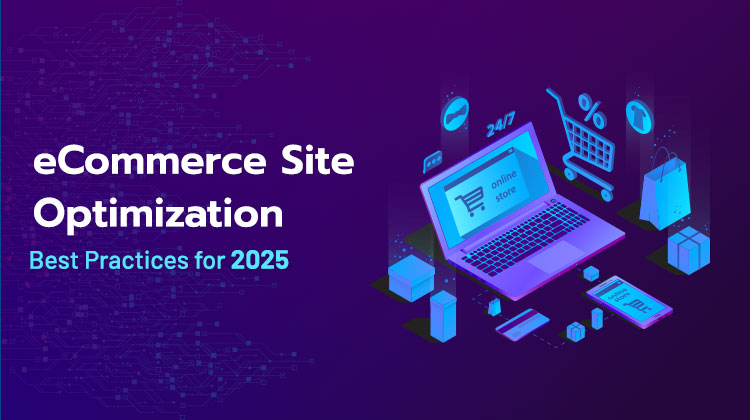
14 Dec, 2024
The eCommerce landscape is evolving rapidly, with global online sales projected to reach $6.3 trillion in 2024. For businesses, this growth presents immense opportunities but also stiff competition. To stand out in a crowded market, eCommerce sites must not only look good but also perform exceptionally well. This is where eCommerce site optimization becomes crucial. It’s not just about improving aesthetics; it’s about enhancing functionality, speed, user experience, and conversions.
In this blog, we’ll explore the best practices for optimizing your eCommerce site in 2025. From leveraging mobile-first design to integrating AI-driven personalization, we’ll provide actionable insights to help you boost engagement and revenue.
Why eCommerce Site Optimization Is Essential in 2025
Consumer expectations have never been higher. According to a study by Google, 53% of mobile users abandon a site if it takes longer than three seconds to load. Meanwhile, Baymard Institute reports that the average cart abandonment rate is nearly 70%. These statistics underscore the importance of eCommerce optimization in providing a seamless shopping experience.
An optimized eCommerce site ensures:
• Faster load times, improving retention rates.
• Enhanced user experience, leading to higher customer satisfaction.
• Better search engine rankings, driving more organic traffic.
Now, let’s dive into the best practices for achieving a well-optimized eCommerce platform.
1. Focus on Speed and Performance
Speed is a make-or-break factor for eCommerce success. Amazon discovered that every 100 milliseconds of latency costs them 1% in sales. This statistic illustrates how even minor delays can have a significant impact on revenue.
How to Optimize for Speed:
• Use Accelerated Mobile Pages (AMP): AMP ensures faster page loading for mobile users.
• Optimize Images: Compress images using tools like TinyPNG or ImageOptim without compromising quality.
• Reduce HTTP Requests: Minimize the number of elements (scripts, stylesheets, images) on each page.
• Leverage Browser Caching: Allow returning visitors to load your site faster by storing some elements locally.
2. Adopt a Mobile-First Design
By 2024, mobile devices are expected to account for nearly 75% of global eCommerce sales. Optimizing your site for mobile users isn’t optional; it’s a necessity.
Best Practices for Mobile Optimization:
• Responsive Design: Ensure your site adapts seamlessly to various screen sizes and orientations.
• Simplify Navigation: Use drop-down menus and search bars to make browsing easy on smaller screens.
• Optimize Checkout for Mobile: Reduce form fields and enable autofill options to speed up the checkout process.
3. Enhance User Experience with Intuitive Navigation
Customers expect to find what they’re looking for quickly and easily. Intuitive navigation improves the shopping journey and encourages higher engagement.
Key Tips for Navigation Optimization:
• Clear Menu Structure: Organize products into logical categories with clear labels.
• Search Functionality: Implement an intelligent search bar with autocomplete and filtering options.
• Breadcrumb Navigation: Help users retrace their steps to avoid frustration.
4. Leverage AI for Personalization
Personalized experiences drive higher conversions. According to McKinsey, 71% of consumers expect companies to deliver personalized interactions, and businesses that get it right generate 40% more revenue.
How to Use AI for Personalization:
• Dynamic Recommendations: Use AI to suggest products based on browsing behavior and purchase history.
• Customized Landing Pages: Tailor landing pages to specific demographics or campaign sources.
• Behavioral Triggers: Send automated emails or pop-ups based on user actions, like cart abandonment.
5. Optimize Product Pages for Conversions
Product pages are where decisions are made. Optimizing them can significantly impact your conversion rates.
Essential Product Page Features:
• High-Quality Images: Include zoomable, multi-angle views and videos to showcase products.
• Detailed Descriptions: Provide clear, engaging, and informative product descriptions with bullet points for easy readability.
• Customer Reviews: Display authentic user reviews to build trust and credibility.
• Urgency Triggers: Use countdowns, limited stock indicators, or free shipping thresholds to encourage faster decisions.
6. Streamline Checkout Processes
The checkout process is where many potential sales are lost. Simplifying this step can drastically reduce cart abandonment rates.
How to Optimize Checkout:
• Enable Guest Checkout: Don’t force users to create an account before purchasing.
• Offer Multiple Payment Options: Include credit cards, digital wallets, and Buy Now Pay Later (BNPL) services.
• Show Progress Indicators: Let users know how many steps are left in the checkout process.
• Pre-Fill Forms: Use saved data for returning customers to reduce friction.
7. Incorporate Voice Search Optimization
Voice search is on the rise, with smart assistants like Alexa and Siri becoming household staples. By 2024, voice commerce is expected to generate over $40 billion in revenue in the U.S. alone.
Tips for Voice Search Optimization:
• Use Conversational Keywords: Optimize product descriptions and FAQ pages for natural language queries.
• Focus on Local SEO: Ensure your store information is up-to-date for location-based voice searches.
• Answer Questions Directly: Create content that addresses common voice search queries, such as “Where can I buy [product] near me?”
8. Invest in SEO and Content Marketing
SEO is a cornerstone of eCommerce optimization. Ranking higher in search results drives organic traffic and reduces dependency on paid ads.
eCommerce SEO Tips:
• Optimize Meta Tags: Include relevant keywords in titles, descriptions, and headers.
• Create Engaging Blog Content: Share product guides, tutorials, and industry insights to build authority.
• Optimize URLs: Use clean, keyword-rich URLs for product and category pages.
9. Partner with an eCommerce Website Development Company
For businesses aiming to create a high-performing online store, partnering with Idiosys Tech, an experienced ecommerce website development company in Kolkata can make a world of difference. These experts specialize in crafting tailored solutions that address your site’s unique needs, from improving page speed to integrating advanced features like AI-powered recommendations and seamless payment gateways.
A professional team ensures that your site meets industry standards and is optimized for both user experience and scalability. Whether you’re launching a new platform or enhancing an existing one, investing in ecommerce website development provides the technical expertise and strategic insights necessary to stay competitive in today’s market.
10. Monitor Performance and Make Data-Driven Decisions
Optimization doesn’t end at launch. Regularly monitoring performance metrics and making data-driven adjustments keep your site competitive.
Tools to Use:
• Google Analytics: Track user behavior, traffic sources, and conversion rates.
• Heatmaps: Understand how users interact with your site.
• A/B Testing: Experiment with layouts, CTAs, and features to see what resonates best with your audience.
Conclusion
As the eCommerce market grows in 2025, eCommerce website optimization will play a critical role in ensuring your business thrives. By focusing on speed, mobile usability, personalization, and streamlined navigation, you can create a seamless shopping experience that delights customers and drives sales.
Don’t overlook the importance of regular analysis and updates to keep your site ahead of trends. Whether you’re just starting or looking to improve an existing platform, implementing these best practices will position your eCommerce business for long-term success.
_________________________________________________________
How often should an eCommerce site be optimized?
Optimization should be an ongoing process to ensure the site adapts to user needs, market trends, and technological advancements.
How does site speed impact an eCommerce store?
Faster sites improve user experience, reduce bounce rates, and increase conversion rates, while slow sites can deter customers.
Why is mobile optimization important for eCommerce?
With a significant percentage of users shopping on mobile devices, mobile optimization ensures a seamless shopping experience and higher conversions.
How can I make my eCommerce site mobile-friendly?
Use responsive design, ensure fast load times, simplify navigation, and optimize images and buttons for touch screens.
Should I optimize my site for voice search?
Yes, optimizing for voice search ensures your site is discoverable for users searching with voice assistants like Siri or Alexa.
_________________________________________________________
You May Also Read
Multi Vendor Marketplace Development: Top Features, Key Challenges, and Proven Solutions
The Important Role of Mobile Optimization for E-commerce Websites in 2024
7 Best Security Practices for eCommerce Websites in 2024
The Voice Revolution: It's Time to Speak Up in E-commerce

